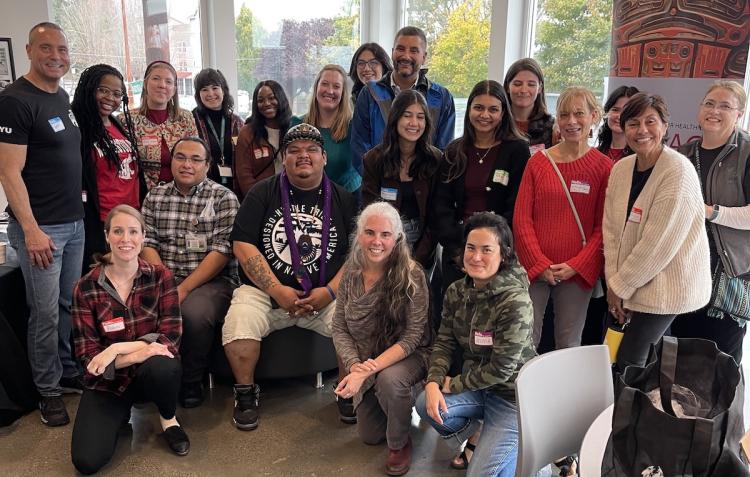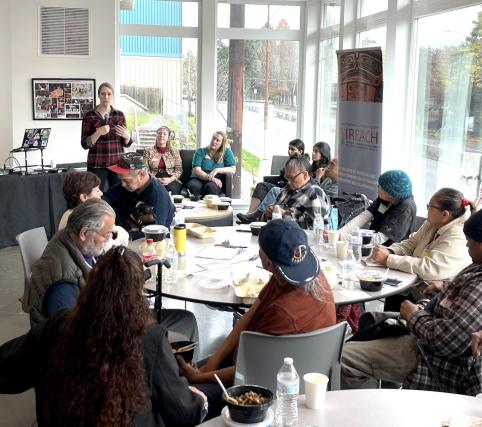
An ADRC outreach event at the Goldfinch elder's housing unit in October 2023, in partnership with our collaborators at Washington State University. Photo: IREACH
“I think one thing that sets our team apart is that we truly want to focus on the community. And we want it to be a partnership” – Breanna Jones (Cherokee and Seminole Ancestry) Research Study Supervisor, WSU IREACH and ADRC
By Katherine Lopez
The Alzheimer's Disease Research Center (ADRC) has many resources dedicated to a diverse set of community members interested in participating in our study on how memory and thinking may change over time. It is important for this research to include everyone, so that findings are relevant to all groups. But this effort is difficult when research is not tailored for all. At the end of the day, research often lacks outreach to diverse communities and translation and adaptation of materials. This is where the NRRC steps in. The NRRC, or the Native Research and Resource Core, was created to increase the enrollment of American Indian and Alaska Native participants into the ADRC. This Core is led by Dedra Buchwald, MD, Principal Investigator Patrik Johansson MD, MPH (Cherokee), and Principal Investigator Gary Ferguson, ND (Unangax^/Aleut).

Breanna Jones, (Cherokee and Seminole Ancestry) Research Study Supervisor, WSU IREACH and ADRC
To fully understand the best approach to diverse research participation, we need to understand why the Native populations are underrepresented. “First and foremost, the historical trauma is a huge factor and barrier to participating in research,” said Breanna Jones, (Cherokee and Seminole Ancestry) Research Study Supervisor, WSU IREACH and ADRC. Mistrust of the medical establishment within communities of color can hinder individuals from participating in research.
To accomplish the goal of recruiting more Native participants, the NRRC has in place 3 phases of enrollment. The first phase involved conducting focus groups with American Indian and Alaska Native community members across the country to get their opinions on how the ADRC currently enrolls participants. In the second phase, the team tailored the study protocol, so that it was better suited to members of Native and Indigenous communities. The third phase is actively enrolling participants with the new culturally adapted protocol.
“I do personally believe, the purpose of the NRRC is to increase access to research and resources for Native communities, as they rightfully deserve to be included in these conversations about health and public health,” says Jones.

An ADRC outreach event at the Goldfinch elder's housing unit in October 2023, in partnership with our collaborators at Washington State University. Photo: IREACH
The NRRC began enrollment March of 2023 with a goal of enrolling 30 participants, and as of late January 2024, the team has enrolled 18 participants. There are many reasons behind this accomplishment. The NRRC put emphasis on community participatory research, as well as created educational resources that are specifically tailored to Indigenous and Native communities. “I think one thing that sets our team apart is that we truly want to focus on the community. And we want it to be a partnership,” said Jones. The NRRC has also recently hired 3 new team members, MichaeLynn Kanichy, MPH (Makah) Research Coordinator, Madalyn Rantala, MS, Research Coordinator, and Jolie Green, Research Study Assistant, who all helped people navigate the enrollment process.
“It's so exciting to see that we are getting closer to representing the diversity of our community in our research cohort,” says Annika Noreen, PhD, PMP, ADRC Program Manager.
In 2024, the NRRC is excited to work towards fostering a strong partnership with organizations including Chief Seattle Club, Daybreak Star Indian Cultural and Seattle Proper, while building new ties with organizations such as the Seattle Indian Health Board. “Together, we can do wonderful things,” said Jones, “I think that we can benefit from one another. It only strengthens our reach that much more.”




